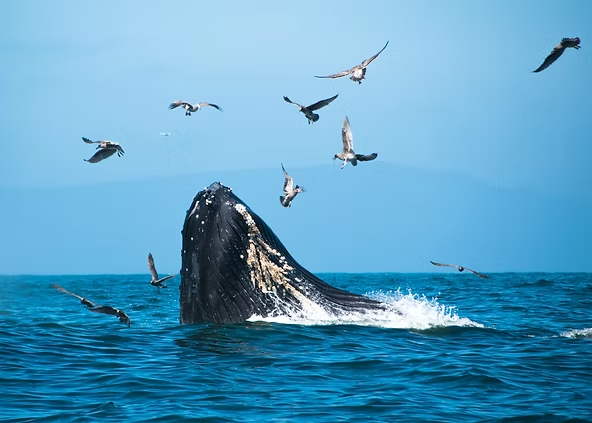What Happens When a Whale Dies?
When a whale dies, its corpse—known as a “whale fall”—creates an energy-rich environment that supports a wide array of deep-sea life. Whale falls are evolutionary anomalies, providing shelter and sustenance for organisms adapted to extreme deep-sea conditions: freezing temperatures, crushing pressures, and total darkness. While most deep-sea creatures feed on “marine snow” (dead phytoplankton, shells, and other organic debris), a whale fall provides an enormous, concentrated source of nutrients.
Discovery and Research
In 2019, marine researchers used the remote-controlled vehicle Hercules near an underwater volcano off central California. While exploring the seabed, Hercules discovered a tiny whale corpse surrounded by fascinating creatures such as eelpouts and sea pigs. The whale fall revealed a rich ecosystem forming around a single whale carcass, demonstrating the vital role of whale deaths in deep-sea life.
Skeletal Remains and “Snot-Flowers”
The whale’s skeleton measured roughly five meters from snout to tail. Baleen, a keratin-based substance used by these whales to filter-feed on krill, remained in the jaw. After death, a whale’s body becomes food for at least 100 species. Marine scavengers arrive first, initiating a “feeding frenzy,” followed by crabs and other tough-shelled organisms that scrape bones into bone dust. Smaller animals, such as octopuses, then feed on these scavengers, creating a complex food web.
Osedax: The Bone-Eating Worm
A specialized species, Osedax, meaning “bone-eating” in Latin, plays a unique role in whale falls. These worms secrete acid to dissolve the whale bone’s outer layer, then extend tiny tendrils into the bone to consume rich proteins like collagen. This remarkable adaptation allows them to extract nutrients from a resource that would otherwise remain locked away, sustaining the deep-sea ecosystem for years.
Importance of Whale Falls
Whale falls are more than just food; they are essential deep-sea habitats. From scavengers to specialized organisms like Osedax, these ecosystems demonstrate how life in the deep ocean thrives on rare but nutrient-rich events. A single whale’s death can sustain an entire community, highlighting the interconnectedness and resilience of oceanic life.

